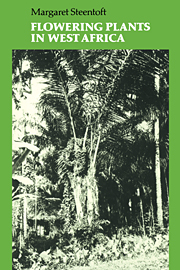Book contents
- Frontmatter
- Contents
- Introduction
- List of symbols and abbreviations
- 1 Species associations
- 2 Vegetation in West Africa
- 3 Annonaceae – soursop family
- 4 Amaranthaceae – amaranth family
- 5 Cucurbitaceae – gourd family
- 6 Ochnaceae – ironwood family
- 7 Combretaceae – afara family
- 8 Guttiferae (Clusiaceae) – butter tree family
- 9 Sterculiaceae – cocoa family
- 10 Bombacaceae – silk cotton family
- 11 Malvaceae – cotton family
- 12 Euphorbiaceae – cassava family
- 13 Caesalpiniaceae – pride of Barbados family
- 14 Mimosaceae – Acacia family
- 15 Papilionaceae – cowpea family
- 16 Ulmaceae – afefe family
- 17 Moraceae – mulberry family
- 18 Meliaceae – mahogany family
- 19 Sapindaceae – akee apple family
- 20 Anacardiaceae – cashew nut family
- 21 Sapotaceae – sheabutternut family
- 22 Apocynaceae – frangipani family
- 23 Asclepiadaceae – blood flower or milkweed family
- 24 Rubiaceae – abura family
- 25 Compositae (Asteraceae) – Tridax family
- 26 Solanaceae – tomato family
- 27 Convolvulaceae – sweet potato family
- 28 Bignoniaceae – jacaranda family
- 29 Acanthaceae – Thunbergia family
- 30 Verbenaceae – teak family
- 31 Labiatae (Lamiaceae) – Hausa potato family
- 32 Commelinaceae – day flower family
- 33 Zingiberaceae – ginger family
- 34 Marantaceae – (West Indian) arrowroot family
- 35 Liliaceae – lily family
- 36 Araceae – cocoyam family
- 37 Palmae (Arecaceae) – palm family
- 38 Orchidaceae – orchid family
- 39 Cyperaceae – sedge family
- 40 Gramineae (Poaceae) – grass family
- General bibliography
- Index of family, generic and common names
21 - Sapotaceae – sheabutternut family
Published online by Cambridge University Press: 02 November 2009
- Frontmatter
- Contents
- Introduction
- List of symbols and abbreviations
- 1 Species associations
- 2 Vegetation in West Africa
- 3 Annonaceae – soursop family
- 4 Amaranthaceae – amaranth family
- 5 Cucurbitaceae – gourd family
- 6 Ochnaceae – ironwood family
- 7 Combretaceae – afara family
- 8 Guttiferae (Clusiaceae) – butter tree family
- 9 Sterculiaceae – cocoa family
- 10 Bombacaceae – silk cotton family
- 11 Malvaceae – cotton family
- 12 Euphorbiaceae – cassava family
- 13 Caesalpiniaceae – pride of Barbados family
- 14 Mimosaceae – Acacia family
- 15 Papilionaceae – cowpea family
- 16 Ulmaceae – afefe family
- 17 Moraceae – mulberry family
- 18 Meliaceae – mahogany family
- 19 Sapindaceae – akee apple family
- 20 Anacardiaceae – cashew nut family
- 21 Sapotaceae – sheabutternut family
- 22 Apocynaceae – frangipani family
- 23 Asclepiadaceae – blood flower or milkweed family
- 24 Rubiaceae – abura family
- 25 Compositae (Asteraceae) – Tridax family
- 26 Solanaceae – tomato family
- 27 Convolvulaceae – sweet potato family
- 28 Bignoniaceae – jacaranda family
- 29 Acanthaceae – Thunbergia family
- 30 Verbenaceae – teak family
- 31 Labiatae (Lamiaceae) – Hausa potato family
- 32 Commelinaceae – day flower family
- 33 Zingiberaceae – ginger family
- 34 Marantaceae – (West Indian) arrowroot family
- 35 Liliaceae – lily family
- 36 Araceae – cocoyam family
- 37 Palmae (Arecaceae) – palm family
- 38 Orchidaceae – orchid family
- 39 Cyperaceae – sedge family
- 40 Gramineae (Poaceae) – grass family
- General bibliography
- Index of family, generic and common names
Summary
Trees and shrubs with latex and fleshy fruits associated with a persistent calyx. In West Africa, most species are large, evergreen forest trees with simple, entire, alternate, leathery leaves with prominent pinnate venation. Flowers are small and white, in axillary clusters, each one three- to eight-part; flower structure in some species is complex. The flowers seldom open widely, never before senescence, and the corolla and staminodes absciss circularly round the base and fall as a piece. The flowers are followed by fleshy or woody berries, sometimes very large, with seeds having relatively large scars. The family is not yet reported growing indigenously in Gambia.
The introduced sapodilla (Manilkara zapotilla) from Central America has grey or brown fruits with sweet red flesh, and the star apple (Chrysophyllum cainito), from the same area, has berries with delicious white or purple flesh. Mimusops elengi (tropical Asia) is sometimes planted for shade.
Flowers ⊕. Simple 5-part flowers occur in Aningeria etc. (K5 [C(5) A5] G(5)), with 5 staminodes alternating with the stamens only in Vincentella and Aningeria. The more complex flowers of Butyrospermum, Tieghemella and Manilkara have 2 whorls each of sepals and petals, appendaged petals (each petal represented by 3 lobes) and petaloid staminodes. Butyrospermum and Tieghemella have 4-part flowers (K4+4 (the whorls dissimilar) [C(8) A8] G(8)), Manilkara has 3-part flowers (K3+3 [C(6) A6] G(6)), all have petaloid staminodes. In Omphalocarpum the flowers are of the simple 5-part type, but there is a group of 2–6 stamens opposite each petal lobe.
- Type
- Chapter
- Information
- Flowering Plants in West Africa , pp. 190 - 195Publisher: Cambridge University PressPrint publication year: 1988



